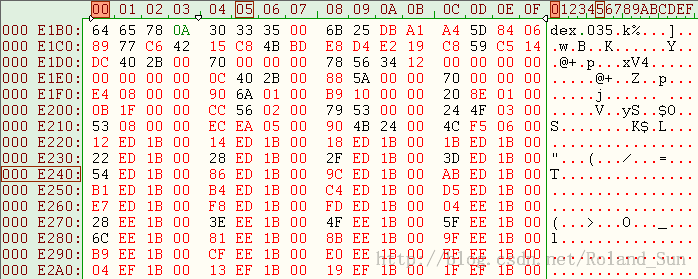Android ART Oat文件格式简析(下)
在上篇中,我们分析到了OatFile的begin_和end_变量分别被指定到了符号oatdata和oatlastword指定的位置。那么指定的这一段数据到底是什么呢?本文会接下来分析。
首先来看OatFile::Setup的实现:
bool OatFile::Setup() {
if (!GetOatHeader().IsValid()) {
LOG(WARNING) << "Invalid oat magic for " << GetLocation();
return false;
}
......GetOatHeader?这是什么东东?接下来看看OatFile::GetOatHeader的实现:
const OatHeader& OatFile::GetOatHeader() const {
return *reinterpret_cast<const OatHeader*>(Begin());
}很简单,就是将前面设置的begin_指向的内存,强制转换成OatHeader。OatHeader又是什么东西?翻出定义看看,只看成员变量定义:
private: uint8_t magic_[4]; uint8_t version_[4]; uint32_t adler32_checksum_; InstructionSet instruction_set_; uint32_t dex_file_count_; uint32_t executable_offset_; uint32_t interpreter_to_interpreter_bridge_offset_; uint32_t interpreter_to_compiled_code_bridge_offset_; uint32_t jni_dlsym_lookup_offset_; uint32_t portable_resolution_trampoline_offset_; uint32_t portable_to_interpreter_bridge_offset_; uint32_t quick_resolution_trampoline_offset_; uint32_t quick_to_interpreter_bridge_offset_; uint32_t image_file_location_oat_checksum_; uint32_t image_file_location_oat_data_begin_; uint32_t image_file_location_size_; uint8_t image_file_location_data_[0]; // note variable width data at end DISALLOW_COPY_AND_ASSIGN(OatHeader); };我们也对照着把文件中的内容拿出来看看,还是以系统的Boot Oat(system@[email protected])为例, oatdata值为0x60a9d000,而通过看Program Header,可以知道elf文件起始被指定映射到了0x60a9c000:

所以,可以知道,oatdata指向的位置在文件中的偏移是0x60a9d000-0x60a9c000=0x1000。拿出二进制编辑工具看看那里有什么:

顿时明白了一切,原来所谓oat文件,其实就是影藏在elf文件中的一个子文件,其有特殊的头和数据格式。我们对照着实际的数据一一做个分析:
1)首先是oat文件的magic code:
const uint8_t OatHeader::kOatMagic[] = { 'o', 'a', 't', '\n' };
2)然后是oat文件的版本号:
const uint8_t OatHeader::kOatVersion[] = { '0', '0', '7', '\0' };
3)接下来是什么checksum,不太重要,暂时忽略;
4)接下来指定oat文件支持的CPU指令集,有以下几种:
enum InstructionSet {
kNone,
kArm,
kThumb2,
kX86,
kMips
};
实际文件中的值是2,对应于Thumb2指令集,也是ARM处理器支持的一种指令集啦。
5)接下来是指定Dex文件的数量,看来例子中的oat文件共包含15个Dex文件;
不明明是oat文件嘛,怎么又来Dex文件啦?其实oat文件是通过Dex文件转换过来的,并且oat文件包含了一个完整的初始的Dex文件,这也就解释了为什么Dex文件转换成oat文件后比原来要大很多。关于这点,先解释到这里,后面碰到的时候还会更具体的分析。
6)可执行部分的偏移,其值是0x18CE000。值得注意的,这里的偏移就不是相对于elf文件头的了,而是相对于oat文件头的。前面说过,oatdata的值为0x60a9d000,所以0x60A9D000+0x18CE000=0x6236B000,正好等于oatexec指向的地址:
而这个虚拟地址0x6236B000,正好是Program Header第三项指定段的起始地址,该段的属性是可读可执行(RE)。真好,全都对应上了。
7)接下来还有一堆偏移,后面碰到再解释;
8)紧接着这些offset的应该是关于Image的一些信息,例子中的文件这些都是0,所以跳过。
好的,解释完OatHeaader后,我们回到OatFile::Setup继续往下看:
const byte* oat = Begin();
oat += sizeof(OatHeader);
if (oat > End()) {
LOG(ERROR) << "In oat file " << GetLocation() << " found truncated OatHeader";
return false;
}
oat += GetOatHeader().GetImageFileLocationSize();
if (oat > End()) {
LOG(ERROR) << "In oat file " << GetLocation() << " found truncated image file location: "
<< reinterpret_cast<const void*>(Begin())
<< "+" << sizeof(OatHeader)
<< "+" << GetOatHeader().GetImageFileLocationSize()
<< "<=" << reinterpret_cast<const void*>(End());
return false;
}
......
这段代码比较容易理解,局部变量oat先获得Oat文件头的位置,然后加上OatHeader结构体的大小,最后还要加上记录Image文件位置的字符串的长度。这时oat变量指向的内存地址刚好就是跳过OatHeader后的位置,应该就是数据区了。好,接着看:
for (size_t i = 0; i < GetOatHeader().GetDexFileCount(); i++) {
size_t dex_file_location_size = *reinterpret_cast<const uint32_t*>(oat);
if (dex_file_location_size == 0U) {
LOG(ERROR) << "In oat file " << GetLocation() << " found OatDexFile # " << i
<< " with empty location name";
return false;
}
oat += sizeof(dex_file_location_size);
if (oat > End()) {
LOG(ERROR) << "In oat file " << GetLocation() << " found OatDexFile # " << i
<< " truncated after dex file location size";
return false;
}
const char* dex_file_location_data = reinterpret_cast<const char*>(oat);
oat += dex_file_location_size;
if (oat > End()) {
LOG(ERROR) << "In oat file " << GetLocation() << " found OatDexFile # " << i
<< " with truncated dex file location";
return false;
}
std::string dex_file_location(dex_file_location_data, dex_file_location_size);
uint32_t dex_file_checksum = *reinterpret_cast<const uint32_t*>(oat);
oat += sizeof(dex_file_checksum);
if (oat > End()) {
LOG(ERROR) << "In oat file " << GetLocation() << " found OatDexFile # " << i
<< " for "<< dex_file_location
<< " truncated after dex file checksum";
return false;
}
uint32_t dex_file_offset = *reinterpret_cast<const uint32_t*>(oat);
if (dex_file_offset == 0U) {
LOG(ERROR) << "In oat file " << GetLocation() << " found OatDexFile # " << i
<< " for "<< dex_file_location
<< " with zero dex file offset";
return false;
}
if (dex_file_offset > Size()) {
LOG(ERROR) << "In oat file " << GetLocation() << " found OatDexFile # " << i
<< " for "<< dex_file_location
<< " with dex file offset" << dex_file_offset << " > " << Size();
return false;
}
oat += sizeof(dex_file_offset);
if (oat > End()) {
LOG(ERROR) << "In oat file " << GetLocation() << " found OatDexFile # " << i
<< " for "<< dex_file_location
<< " truncated after dex file offset";
return false;
}
......
}
最开始,根据前面得到的Dex文件数进行遍历。为了方便理解,我们还是结合实际文件中的值来看:
首先得到的是dex文件位置字符串的大小,这里是0x21,就是有33个字符。紧接着的就是具体的dex文件的位置信息,这里是”/system/framework/core-libart.jar“,可以数数,刚好是33个字符。再下面4个字节是对应此dex文件的checksum。再下面记录的是dex文件相对oat头地址的偏移,此例中是0xD1B0,由于这是相对于oat头位置的偏移,加上oat头相对于elf头的0x1000偏移,所以应该在0xE1B0处找,我们看看那有什么:
看到没有,是不是非常熟悉呢?众里寻他千百度,暮然回首,那人却在灯火阑珊处,这里就是转换前的dex文件所在地呀。好了,接着分析剩下的代码:
const uint8_t* dex_file_pointer = Begin() + dex_file_offset;
if (!DexFile::IsMagicValid(dex_file_pointer)) {
LOG(ERROR) << "In oat file " << GetLocation() << " found OatDexFile # " << i
<< " for "<< dex_file_location
<< " with invalid dex file magic: " << dex_file_pointer;
return false;
}
if (!DexFile::IsVersionValid(dex_file_pointer)) {
LOG(ERROR) << "In oat file " << GetLocation() << " found OatDexFile # " << i
<< " for "<< dex_file_location
<< " with invalid dex file version: " << dex_file_pointer;
return false;
}
const DexFile::Header* header = reinterpret_cast<const DexFile::Header*>(dex_file_pointer);
const uint32_t* methods_offsets_pointer = reinterpret_cast<const uint32_t*>(oat);
oat += (sizeof(*methods_offsets_pointer) * header->class_defs_size_);
if (oat > End()) {
LOG(ERROR) << "In oat file " << GetLocation() << " found OatDexFile # " << i
<< " for "<< dex_file_location
<< " with truncated method offsets";
return false;
}
oat_dex_files_.Put(dex_file_location, new OatDexFile(this,
dex_file_location,
dex_file_checksum,
dex_file_pointer,
methods_offsets_pointer));
}此时,局部变量dex_file_pointer已经指向了dex文件的位置。代码会先验证一下该dex文件的magic code和版本号。接着局部变量header被强制类型转换成DexFile::Header类型,表示dex的文件头位置。而另一个局部变量methods_offsets_pointer指向了前面dex文件偏移的后4个字节,局部变量名的意思是指向一个什么方法偏移指针数组,而且这个数组成员的个数,似乎还跟dex文件头中的class_defs_size_有联系。很奇怪是吧,这是什么东西呢?那么
class_defs_size_代表什么意思?熟悉dex文件格式的人应该都知道,这里稍微提一下,它其实就表示dex文件中共包含了几个类。再结合变量名联想一下,猜测这个指针指向的是一个数组,元素个数就是dex文件中定义的类的个数,数组内的元素都是一些偏移,指向的是一组方法,这些方法我猜测就对应的是各个类内部定义的方法。空口无凭,我们来简单验证一下,首先看看对应的dex文件中有几个类:
为什么在这,我不解释。好,一共有0x853个类。而methos_offsets_pointer_指向的值是0x106D。好,我们在简单计算一下0x106D+4*0x853=0x31B9,这个位置有什么呢,我们再看看:
看见了没有,刚好是表示下一个dex文件信息的开头。那数组中具体每个偏移指到的是什么呢?先别忙,我们再接下来分析。OatFile::Setup还剩下最后一部分:
oat_dex_files_.Put(dex_file_location, new OatDexFile(this,
dex_file_location,
dex_file_checksum,
dex_file_pointer,
methods_offsets_pointer));
}
return true;
}往自己的内部变量oat_dex_files_中插入一项,插入的是什么呢?创建了一个OatDexFile的对象,这又是什么?从中能不能知道前面问题的答案呢,让我们来看看OatFile::OatDexFile::GetOatClass函数:
const OatFile::OatClass* OatFile::OatDexFile::GetOatClass(uint16_t class_def_index) const {
uint32_t oat_class_offset = oat_class_offsets_pointer_[class_def_index];
const byte* oat_class_pointer = oat_file_->Begin() + oat_class_offset;
CHECK_LT(oat_class_pointer, oat_file_->End()) << oat_file_->GetLocation();
mirror::Class::Status status = *reinterpret_cast<const mirror::Class::Status*>(oat_class_pointer);
const byte* methods_pointer = oat_class_pointer + sizeof(status);
CHECK_LT(methods_pointer, oat_file_->End()) << oat_file_->GetLocation();
return new OatClass(oat_file_,
status,
reinterpret_cast<const OatMethodOffsets*>(methods_pointer));
}这个函数是用来在Oat文件中找所谓OatClass的。其中oat_class_offsets_pointer_是前面提到的那个偏移数组,从中我们大致可以了解到底这些偏移指向的东西是什么。首先,根据传入的类定义序号找到相应的偏移,然后加上oat文件头地址,得到绝对地址,付给变量oat_class_pointer,从字面来看是所谓的oat类指针,这又是什么呢?接着强制转换成mirror::Class::Status,这是一个枚举值:
enum Status {
kStatusError = -1,
kStatusNotReady = 0,
kStatusIdx = 1, // Loaded, DEX idx in super_class_type_idx_ and interfaces_type_idx_.
kStatusLoaded = 2, // DEX idx values resolved.
kStatusResolved = 3, // Part of linking.
kStatusVerifying = 4, // In the process of being verified.
kStatusRetryVerificationAtRuntime = 5, // Compile time verification failed, retry at runtime.
kStatusVerifyingAtRuntime = 6, // Retrying verification at runtime.
kStatusVerified = 7, // Logically part of linking; done pre-init.
kStatusInitializing = 8, // Class init in progress.
kStatusInitialized = 9, // Ready to go.
};这些应该表明该类的当前状态。除去
mirror::Class::Status枚举的长度后,接下来指向的是OatMethodOffsets结构体数组,定义如下:
class PACKED(4) OatMethodOffsets {
public:
......
uint32_t code_offset_;
uint32_t frame_size_in_bytes_;
uint32_t core_spill_mask_;
uint32_t fp_spill_mask_;
uint32_t mapping_table_offset_;
uint32_t vmap_table_offset_;
uint32_t gc_map_offset_;
};
共由7个变量组成,第一个从字面上看是代码偏移。
我们还是顺着刚才的例子,找第一个偏移看看那到底有什么:
哦,看来该类应该已经初始化完成了(状态值为9),第一个方法的代码段偏移是0x18CE045,第二个方法的代码段偏移是0x18CE0D4。
好了,分析到这里应该已经差不多了,下面简单总结一下什么是oat文件,以及它的一些特性:
1)oat文件其实是包含在一个elf文件中的,符号oatdata和oatlastword分别指定了oat文件在elf文件中的头和尾的位置,符号oatexec指向可执行段的位置;
2)对于包含oat的elf文件来说,如果是Boot Oat,则其是要被加载到一个固定的地址上的,具体来说是紧接着Image文件之后。而对于普通应用程序的oat文件来说,可以被加载到内存中的任何位置;
3)oat文件有自己的头和格式,并且其内部包含了一个完整的dex文件。



